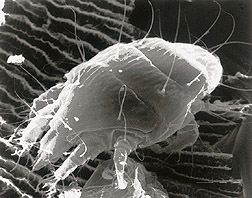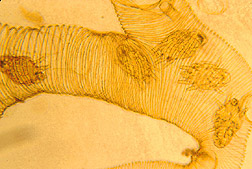Honey Bees Mite Breathe Easier:
|
|
|
|
Pollinating crops keeps honey bees busy. But some bees are more vulnerable than others when it comes to getting "winded" because of tiny tracheal mites that clog their airways.
Now, plans are in the works to create a new service that breeders can use to check their bees' mettle against the parasitic mite,Acarapis woodi. Scientists behind the plan expect it to speed efforts to pinpoint tracheal mite-resistance traits worth breeding into the entire U.S. honey bee population, whose crop-pollinating duties are a $15-billion asset to the nation's agriculture. Under the plan, Agricultural Research Service entomologists in Baton Rouge, Louisiana, are providing a Shelbyville, Tennessee, beekeeper with the scientific expertise necessary to conduct mite-resistance testing as a commercial service. Through such a service, for example, a client could decide to cull a susceptible queen breeder colony or further propagate one that fares well against the mites. A similar service operated in Ontario, Canada, helped the industry there reduce the mite-to-bee ratio from 13 mites per bee to 1.5. |
|
|
"We believe the most effective way to enhance resistance is to make certain that breeding colonies can be tested for resistance and encourage U.S. breeders to test their colonies," says Robert G. Danka, an entomologist with ARS' Honey Bee Breeding, Genetics and Physiology Laboratory, in Baton Rouge. There, he and ARS colleague entomologist José D. Villa have used a protocol for testing and characterizing the relative resistance levels of bee stocks subjected to heavy mite infestations. Through such research, for example, they've discovered one resistant honey bee strain that fends off the mites through a behavioral trait called autogrooming. Simply put, this refers to the bees' use of their legs to comb crawling tracheal mites out of the hairs on their bodies. In trials, susceptible bees used as checks weren't so limber and averaged more mites than resistant bees had. In the May 2000 issue of theAmerican Bee Journal, the two researchers published results of a survey in which they characterized mite-resistance levels in 83 breeder colonies managed by 8 commercial queen producers in California, Hawaii, Louisiana, Texas, and Virginia. Specifically, they tested young worker bees from the breeder colonies and compared them to bees from colonies known to be resistant or susceptible. Of the surveyed colonies, two-thirds proved resistant, while one-fourth were clearly very susceptible. "It's remarkable how variable resistance is in the breeding pool," says Danka. Eager to transfer what they learned to the U.S. bee industry, the researchers raised the idea for a commercial testing service at a bee breeders' conference held in January 2000 in Fort Worth, Texas. Backwood Apiaries owner Edwin R. Holcombe attended that meeting. "I was listening and decided to participate," says Holcombe, who has been a commercial queen bee breeder since 1973, and owns 80 hives. Tracheal mites "are still a serious problem to beekeeping," he adds, "though theVarroa mite has been getting the attention." In April, Holcombe spent a week at the ARS scientists' Baton Rouge laboratory to learn their mite-testing protocol firsthand. It includes managing colonies of resistant and susceptible bee stock for use as reference points, maintaining "inoculation colonies" that are infested with mites, and tending combs with developing young bees in incubators. Young adult bees that emerge from the combs are carefully marked and placed in the mite-infested colonies. After a week, the test bees are retrieved, dissected, and checked under a microscope for mites. Once Holcombe feels he's honed these skills, Danka and Villa will put them to the test before certifying Holcombe's proficiency—and for good reason: The testing service envisioned calls for handling at least 15 colonies from as many as 10 queen-breeder clientele, on a first-come, first-served basis. "I plan one more practice run," says Holcombe, who is eyeing a summer 2001 debut. Then it'll be time to get down to beesness.—By Jan Suszkiw, Agricultural Research Service Information Staff. This research is part of Crop Production, Product Value, and Safety, an ARS National Program (#305) described on the World Wide Web at http://www.nps.ars.usda.gov. Robert G. Danka and José D. Villa are with the USDA-ARS Honey Bee Breeding, Genetics and Physiology Laboratory, 1157 Ben Hur Road, Baton Rouge, LA 70820; phone (225) 767-9294, fax (225) 766-9212. |
|
"Honey Bees Mite Breathe Easier " was published in the March 2001 issue of Agricultural Research magazine. |
|








